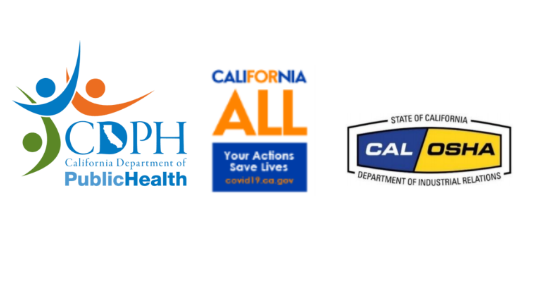Title Page
-
Conducted on
-
Prepared by
-
Location
Contents of Written Worksite Specific Plan
-
The person(s) responsible for implementing the plan.
-
A risk assessment and the measures that will be taken to prevent spread of the virus.
-
Training and communication with employees and employee representatives on the plan.
-
A process to check for compliance and to document and correct deficiencies.
-
A process to investigate COVID-cases, alert the local health department, and identify and isolate close workplace contacts of infected employees until they are tested.
-
Update the plan as necessary to prevent further cases.
-
Employers engaged in the construction of energy and utility infrastructure should also refer to the directions for construction employers.
-
Incorporate COVID-19 precautions into emergency planning for mass outages, fires, etc. (see detailed guidance).
Topics for Employee Training
-
Information on COVID-19, preventing spread, and who is especially vulnerable. <br>https://www.cdc.gov/coronavirus/2019-ncov/index.html
-
Self-screening at home, including temperature and/or symptom checks using CDC guidelines.<br>https://www.cdc.gov/coronavirus/2019-ncov/symptoms-testing/symptoms.html
-
The importance of not coming to work if employees have a frequent cough, fever, difficulty breathing, chills, muscle pain, headache, sore throat, the recent loss of taste or smell, or if they or someone they live with has been diagnosed with COVID-19.
-
When to seek medical attention.
-
The importance of hand washing.
-
The importance of physical distancing, both at work and off work time.
-
Proper use of cloth face covers
Individual Control Measures and Screening
-
Symptom screenings and/or temperature checks.
-
Encourage workers who are sick or exhibiting symptoms of COVID-19 to stay home.
-
Encourage frequent handwashing and use of hand sanitizer.
-
Provide disposable gloves to workers using cleaners and disinfectants if required. Consider gloves a supplement to frequent hand washing for other cleaning, tasks such as handling commonly touched items or conducting symptom screening.
-
Strongly recommend use of cloth face covers.
-
Reconfigure, restrict or close break areas and provide alternative spaces where physical distancing can occur.
-
Provide the necessary equipment and accommodations for line crews that may need to respond to grid disruption.
-
Conduct daily safety briefings prior to field workers going on service calls.
Cleaning and Disinfecting Protocols
-
Perform thorough cleaning in high traffic areas.
-
Frequently disinfect commonly used surfaces.
-
Clean and sanitize shared equipment between each use.
-
Clean touchable surfaces between shifts or between users, whichever is more frequent.
-
Ensure that sanitary facilities stay operational and stocked at all times and provide additional soap, paper towels, and hand sanitizer.
-
Use products approved for COVID-19 on the Environmental Protection Agency (EPA)-approved list and follow product instructions and Cal/OSHA requirements.<br>https://www.epa.gov/pesticide-registration/list-n-disinfectants-use-against-sars-cov-2
-
Provide time for workers to implement cleaning practices before and after shifts, hire third-party cleaning companies.
-
Install hands-free devices if possible.
-
Clean and sanitize personal equipment.
-
Consider upgrades to improve air filtration and ventilation.
Physical Distancing Guidelines
-
Implement measures to physically separate workers by at least six feet using measures such as physical partitions or visual cues (e.g., floor markings, colored tape, or signs to indicate to where workers should stand).
-
Minimize exposure between employees and customers where physical distancing cannot be maintained, such as plexiglass barriers.
-
Use signage to remind employees and customers of physical distancing and face cover use at all entrances and strategically throughout the facility.
-
Adjust in-person meetings, if they are necessary, to ensure physical distancing.
-
Place additional limitations on the number of workers in enclosed areas to ensure at least six feet of separation.
-
Stagger employee breaks, in compliance with wage and hour regulations, to maintain physical distancing protocols.
-
Develop a process workflow for employees to use to identify suspected COVID-19 concerns during customer calls.
-
Contact customers before visits to confirm appointments and check if there are infected people on-premises.
-
Allow field personnel to call a “safety stop” when they are reluctant to enter a dwelling or other building.
-
Limit exposure for field technicians and personnel by implementing remote diagnostics and self-install/repair strategies wherever possible.
-
For field workers operating in a restricted area or containment zone, organizations should consider:<br><br>o Offering alternate lodgings, such as mobile homes and RVs equipped with<br>washer/dryers, showers, and kitchens.<br>o Dividing workers into small teams that do not comingle.<br>o Instituting triple wellness checks with mandatory temperature and/or<br>symptom screenings at arrival, at mid-shift, and when going off-duty, with a<br>health survey.
-
Identify essential employees to develop effective strategies for mitigating their risk of infection. Develop a plan if they need to be removed from the workforce.
-
Segregate crews to limit cross-contamination.
-
Limit outside visitors.
-
Consider which, if any, personnel can perform their jobs in spaces adjacent to an existing control room.
-
Workstations should allow for at least six feet of space between employees. Physical barriers between employees can be used for additional protection when six feet of distance is not possible.
-
Contractors/vendors should be screened with a health questionnaire and/or temperature check and encouraged to wear face covers. Access should be limited to critical activities only.
-
Consider control room functions that can be performed remotely, like monitoring or data analytics.
-
Control center support staff should be allowed to work remotely to the extent permissible.
-
Logistics plans for housing operators onsite, including bedding, hygiene facilities, entertainment, and food accommodations, should be developed.
Sign Off
-
Name and Signature
















